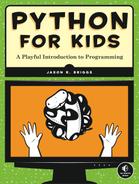0%
35Chapters
0-1Hours read
0kTotal Words
Book Description
Full of fun examples and color illustrations, Python For Kids is a playful introduction to Python that will help any beginner get started with programming.
Table of Contents
- Python for Kids
- About the Author
- About the Illustrator
- About the technical Reviewers
- Acknowledgments
- Introduction
- I. Learning to Program
- 1. Not All Snakes Slither
- 2. Calculations and Variables
- 3. Strings, Lists, Tuples, and Maps
- 4. Drawing with Turtles
- 5. Asking Questions with if and else
- 6. Going Loopy
- 7. Recycling Your Code with Functions and Modules
- 8. How to Use Classes and Objects
- 9. Python’s Built-in Functions
- 10. Useful Python Modules
- 11. More Turtle Graphics
- 12. Using tkinter for Better Graphics
- Creating a Clickable Button
- Using Named Parameters
- Creating a Canvas for Drawing
- Drawing Lines
- Drawing Boxes
- Drawing Arcs
- Drawing Polygons
- Displaying Text
- Displaying Images
- Creating Basic Animation
- Making an Object React to Something
- More Ways to Use the Identifier
- What You Learned
- Programming Puzzles
- II. Bounce!
- III. Mr. Stick Man Races for the Exit
- 15. Creating Graphics for the Mr. Stick Man Game
- 16. Developing the Mr. Stick Man Game
- 17. Creating Mr. Stick Man
- 18. Completing the Mr. Stick Man Game
- A. Where to Go from Here
- B. Python Keywords
- Glossary
- Index
- About the Author
- Updates
- Copyright
